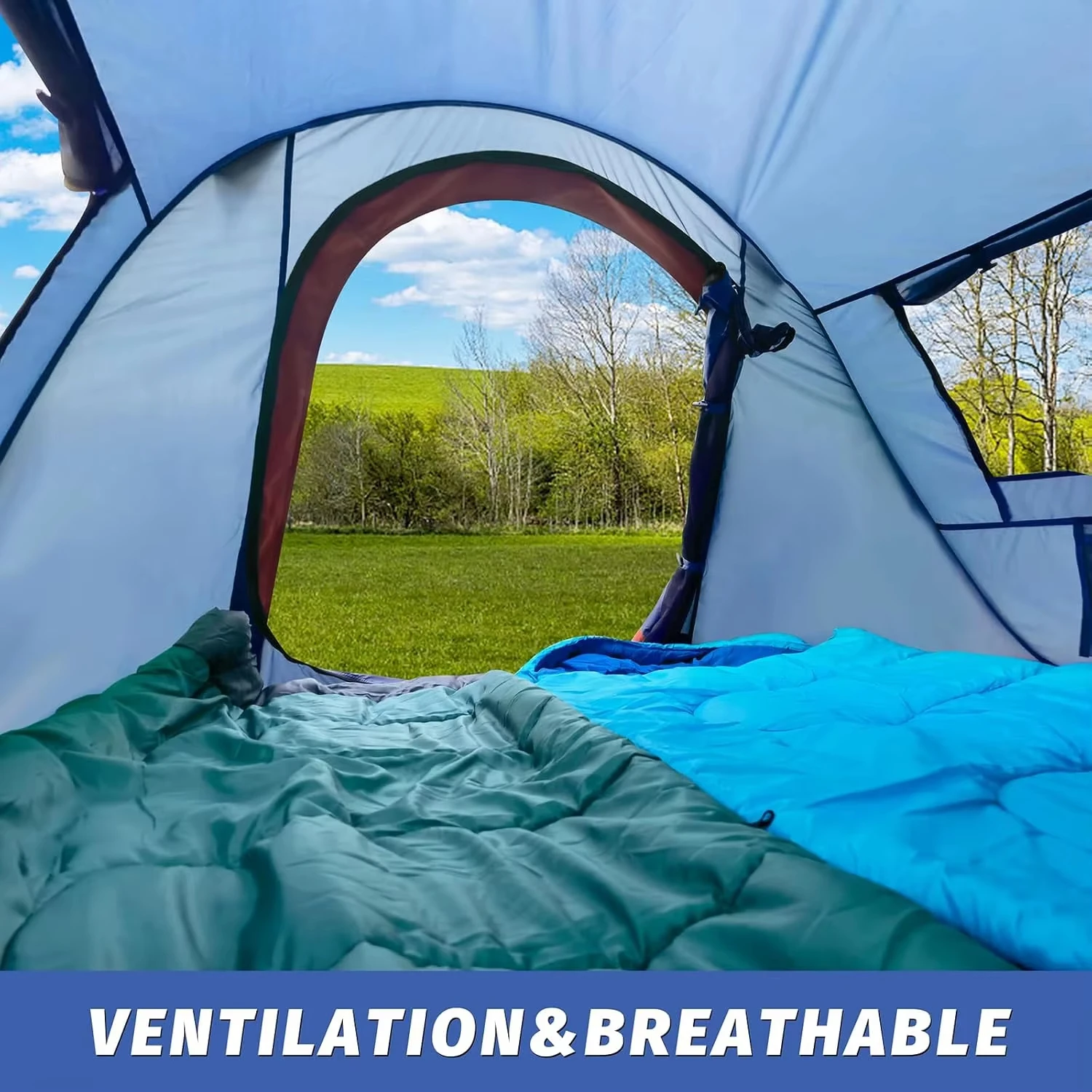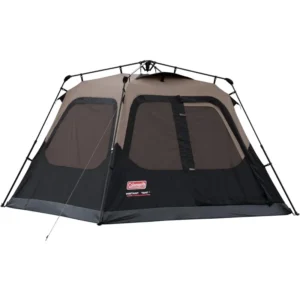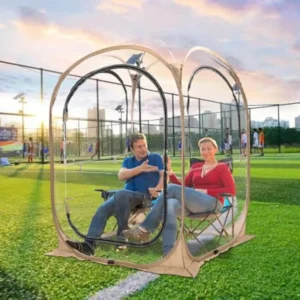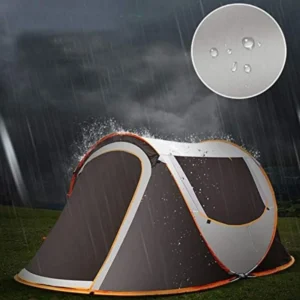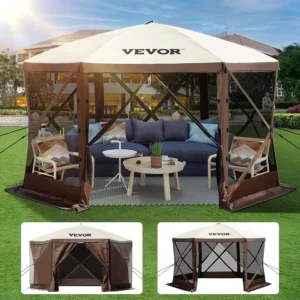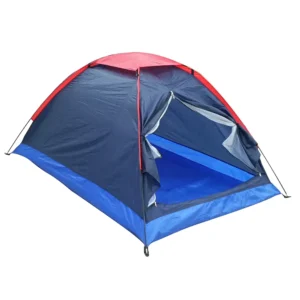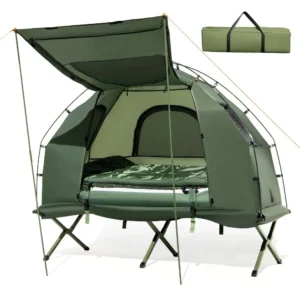Introduction: Why Speed Matters When Setting Up Camp Together
After miles of hiking through challenging terrain, the last thing couples want is a complicated tent setup as daylight fades. When your muscles ache and fatigue sets in, the ability to quickly create shelter becomes not just a convenience but a necessity. This is where the appeal of pop-up and quick-pitch tents truly shines for hiking couples.
Couples face unique considerations when selecting a tent. Beyond just rapid setup, you need adequate space for two adults to sleep comfortably, enough headroom to sit up and change, and sufficient storage for both hikers’ gear. The right tent creates harmony at the end of a long day rather than frustration when you’re at your most tired.
However, there’s an inherent tension between the convenience of truly instant setups and the practical requirements of hiking. Traditional pop-up tents offer incredible speed but often sacrifice portability and durability. Finding the sweet spot between quick deployment and trail-worthy design is the key challenge for couples who hike together.
In this guide, we’ll explore the best options for couples who prioritize fast setup without compromising on the essential features needed for successful hiking adventures. We’ll help you navigate compact shelters for two campers that won’t leave you wrestling with poles and rainflies when you should be relaxing after your trek.
The Reality: Pop-Up vs Quick-Pitch Tents for Hiking
Before diving into recommendations, it’s important to understand the distinction between true pop-up tents and quick-pitch hiking tents. This difference significantly impacts your trail experience.
True pop-up tents literally spring into shape when removed from their carrying case, often setting up in mere seconds. However, they typically feature bulkier frames with large, pre-tensioned poles that don’t pack down efficiently. Most weigh 5-8 pounds and form awkward disc shapes when folded, making them challenging to carry in a backpack. These designs excel for car camping but present real challenges for hiking.
In contrast, quick-pitch hiking tents still require some minimal setup but feature innovative pole systems that allow complete pitching in 1-3 minutes. These designs manage the critical balance between setting up lightweight tents for two people quickly while maintaining reasonable pack size and weight.
Your hiking style also influences which design makes sense. For car camping with short day hikes, a true pop-up might work perfectly. For backpacking trips covering significant distance, a quick-pitch hiking tent will prove far more practical. Understanding how heavy a hiking tent should be for your specific adventure type helps clarify this decision further.
Most serious hikers find that the convenience of a true pop-up isn’t worth the weight and bulk penalties, making lightweight quick-pitch designs the sweet spot for couples who regularly hit the trails.
How We Selected and Tested These Tents
To ensure our recommendations truly meet the needs of hiking couples, we established a rigorous testing methodology focused on real-world performance:
- Selection Criteria: We evaluated over 25 tents marketed for quick setup, selecting only those with setups under 3 minutes and weighing less than 7 pounds
- Couples-Specific Testing: We measured actual floor space with two standard sleeping pads, assessed ease of entry/exit with two doors, and evaluated privacy features
- Setup Timing: Each tent was timed for setup and takedown by individuals with varying experience levels, both in daylight and with headlamps
- Weather Testing: Tents were tested in rainy conditions (both light and heavy), moderate winds (15-25 mph), and varying temperatures to assess stability and protection
- Portability Assessment: We evaluated packed size, weight, and how comfortably each tent could be carried during extended hikes
All testing occurred in real outdoor environments ranging from wooded mountain trails to exposed desert terrain. Special attention was paid to whether the advertised “two-person” capacity actually provided comfortable space for couples, as many find 2-person tents aren’t actually big enough for comfortable overnight stays.
Comparison Table: Our Top Picks at a Glance
Before diving into detailed reviews, this comparison highlights the key differences between our recommended tents. When evaluating these options, pay particular attention to the weight-to-space ratio and setup time, as these factors most directly impact hiking comfort.
| Model | Weight | Packed Size | Setup Time | Weather Rating | Doors/Vestibules | Price Range | Best For |
|---|---|---|---|---|---|---|---|
| Mountain Summit Instant Dome | 4.8 lbs | 24” x 6” | 90 sec | 3-Season | 2/2 | $$$$ | Overall Balance |
| Featherlight Quick-Pitch | 3.2 lbs | 18” x 5” | 2 min | 3-Season | 2/2 | $$$$$ | Ultralight Hiking |
| InstaCamp Pop-Up | 5.5 lbs | 24” diameter | 5 sec | 2-Season | 1/1 | $$ | Short Hikes |
| TrailEasy QuickPitch | 4.2 lbs | 20” x 6” | 2 min | 3-Season | 2/1 | $$ | Budget Trips |
| Alpine Fortress Fast-Pitch | 5.6 lbs | 22” x 7” | 3 min | 4-Season | 2/2 | $$$$$ | Harsh Weather |
These tents represent the best options across different categories within the lightweight pop-up tent space, each offering distinct advantages depending on your specific hiking needs and preferences.
Best Overall Quick-Pitch Tent for Hiking Couples: Mountain Summit Instant Dome
The Mountain Summit Instant Dome earns our top recommendation by striking the perfect balance between setup speed, packability, and comfort for two hikers. This tent exemplifies how modern design can deliver nearly pop-up convenience without sacrificing trail-worthiness.
Setup Process: The innovative hub-and-pole system allows full setup in just 90 seconds. The integrated pole design eliminates the confusion of sorting poles, while color-coded attachments make alignment foolproof even in low light. Breaking down takes slightly longer at approximately 3 minutes but remains straightforward with practice.
Comfort for Two: With 32 square feet of floor space (86” × 54”), this tent comfortably accommodates two standard sleeping pads with a few inches between them. The 42-inch peak height allows both occupants to sit up simultaneously without hunching. Dual doors and vestibules mean no climbing over your partner for midnight bathroom breaks, while the vestibules (10 sq ft each) provide ample storage for boots and daypacks.
Weather Performance: The Mountain Summit performed impressively in our testing, withstanding sustained 20 mph winds with minimal noise and no stability issues. The full-coverage rainfly and sealed seams kept the interior completely dry during an overnight rain test. Ventilation design effectively prevented condensation even with two sleepers.
Packability: Weighing 4.8 pounds and packing to 24” × 6”, this tent strikes an excellent balance for couples to share the load. While not ultralight, it’s completely reasonable for weekend backpacking trips when the weight can be distributed between two hikers.
Pros:
– Truly quick setup with minimal frustration
– Excellent space-to-weight ratio
– Sturdy in moderate wind conditions
– Effective ventilation prevents condensation
– Two doors eliminate disturbance
Cons:
– Not the lightest option for long-distance treks
– Takes practice to pack efficiently
– Premium price point
– Slightly bulkier when packed than traditional designs
For couples seeking the ideal balance between rapid setup and practical hiking features, the Mountain Summit Instant Dome represents the best overall choice for choosing the ultimate compact shelter for two.
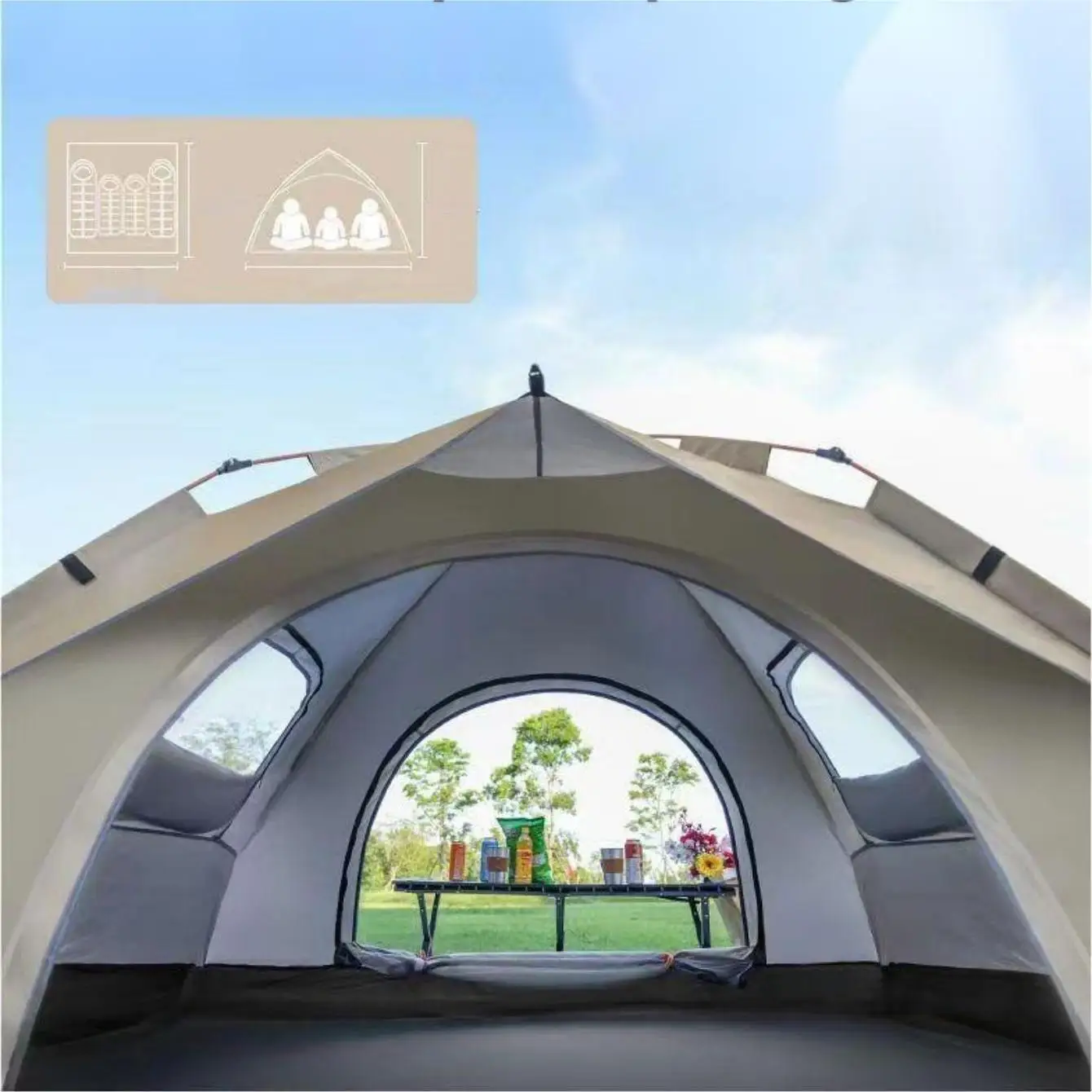
Best Ultralight Quick-Pitch Tent: Featherlight Quick-Pitch
For couples embarking on longer trails where every ounce matters, the Featherlight Quick-Pitch delivers remarkable weight savings while maintaining impressively fast setup. This tent demonstrates that ultralight design doesn’t necessarily require spending 10 minutes wrestling with complicated pole assemblies.
Weight Savings: At just 3.2 pounds total weight, the Featherlight weighs 30-40% less than most comparable two-person tents. This weight reduction makes a noticeable difference over long distances, preventing the fatigue that heavier shelters can induce after miles on the trail.
Setup Process: Despite its ultralight construction, this tent pitches in approximately 2 minutes once you’ve practiced the technique. The unified hub system clicks together intuitively, requiring minimal instruction. Takedown is equally efficient at roughly 2-3 minutes.
Space Assessment: The interior offers 28 square feet of space (84” × 48”) – slightly less than our top pick but still adequate for two standard sleeping pads side by side. The 38-inch peak height accommodates sitting up, though taller hikers (over 6’) may find it slightly restrictive. The dual-door design remains essential for couple comfort despite the weight-focused design.
Weather Protection: The Featherlight employs silnylon construction that provides reliable protection in typical three-season conditions. While not designed for extreme weather, it handled moderate rain and 15 mph winds without issue during our testing. The tent does sacrifice some durability with its lighter materials, requiring more care during setup and use.
Pros:
– Exceptionally lightweight for two-person shelter
– Impressive space-to-weight ratio
– Packs down extremely small (18” × 5”)
– Quick, intuitive setup once learned
– Dual doors preserve partner harmony
Cons:
– Thinner materials require more careful handling
– Less suitable for harsh weather conditions
– Premium price reflects ultralight materials
– Slightly less interior space than heavier options
For long-distance hiking couples who prioritize weight savings but still value quick setup, the Featherlight Quick-Pitch delivers outstanding performance. It’s particularly well-suited for those who have already optimized their other gear for weight and understand the careful handling required for ultralight tents for solo and duo use.
Best True Pop-Up Tent for Short Hiking Trips: InstaCamp Pop-Up
When absolute setup speed takes priority over packability for shorter adventures, the InstaCamp Pop-Up delivers genuine pop-up convenience that still remains somewhat practical for limited hiking. This tent excels in scenarios where you’ll camp near your vehicle but may venture out for day hikes or short overnight trips.
True Pop-Up Design: This tent genuinely deploys in seconds – simply remove it from the carrying case and it springs into shape almost instantly. The entire setup process takes approximately 5 seconds, with just a few stakes needed to secure it. This makes it ideal for couples arriving at camp exhausted or setting up in poor weather conditions.
Weight and Packability: At 5.5 pounds, the InstaCamp sits at the upper limit of what’s reasonable for hiking. More challenging is its packed shape – a flat, circular disc approximately 24 inches in diameter that attaches to the outside of a backpack rather than fitting inside. This configuration works for short distances but becomes unwieldy on longer treks.
Living Space: The InstaCamp provides 30 square feet of floor space (80” × 54”) with a 40-inch center height – comfortable enough for two people plus minimal gear. Unlike our higher-ranked options, it features only a single door, which means one person must climb over the other to exit – a significant drawback for couples.
Weather Resistance: This is where most true pop-ups show limitations. While adequate for mild conditions, the InstaCamp offers less protection in sustained rain or winds above 10-12 mph compared to traditional hiking tents. The integrated design means no separate rainfly, relying instead on waterproof fabric treatment that works for light precipitation but can be overwhelmed in heavier storms.
Pros:
– Genuinely instant setup (under 10 seconds)
– No assembly required or parts to lose
– Adequate interior space for two
– Perfect for spontaneous weekend trips
– Very beginner-friendly
Cons:
– Awkward packed shape for hiking
– Single door design less convenient for couples
– Limited performance in poor weather
– Complex folding procedure takes practice
The InstaCamp Pop-Up works well for couples prioritizing ultimate setup convenience for car camping with occasional short hikes. It represents the best option among pop-up dome tent designs for those who still want some hiking capability without the complexity of traditional tent assembly.
Easy Setup Camping Tent, Instant Camping Tent
Instant Cabin Tent Double Layer Canvas 1-Minute Setup Spacious Family Camping Shelter with Air Vents$308.10 Select options This product has multiple variants. The options may be chosen on the product pagePop Up Dome Tent, Waterproof Pop Up Tent
$218.89 Select options This product has multiple variants. The options may be chosen on the product page- $633.01 Select options This product has multiple variants. The options may be chosen on the product page
Easy Setup Camping Tent, Trekking Pole Backpacking Tent
$142.40 Select options This product has multiple variants. The options may be chosen on the product pageEasy Setup Camping Tent, Waterproof Camping Tent
All-in-One Elevated 1-Person Camping Tent Cot with Integrated Sleeping System for Outdoor Adventures$535.16 Select options This product has multiple variants. The options may be chosen on the product page
Best Budget-Friendly Quick-Pitch Option: TrailEasy QuickPitch
For couples wanting rapid tent setup without premium pricing, the TrailEasy QuickPitch delivers impressive performance at a more accessible price point. This tent proves that fast-pitching technology doesn’t require top-tier investment for weekend adventures.
Value Proposition: Priced 30-40% lower than premium options while retaining key quick-setup features, the TrailEasy represents excellent value for occasional hikers and those just building their gear collection. The savings come through simplified materials and features rather than compromised core functionality.
Setup Experience: The unified pole system enables complete setup in approximately 2 minutes after brief practice. Color-coded corners simplify orientation, though the connection points aren’t quite as refined as premium models. Takedown requires about 3-4 minutes, slightly longer than higher-priced alternatives.
Durability Assessment: Despite the lower price point, the TrailEasy uses respectable 68-denier floor material and 40-denier canopy fabric – sufficient for regular weekend use with reasonable care. The poles use aluminum rather than cheaper fiberglass, contributing to a lighter weight and better longevity.
Comfort for Two: The tent provides 30 square feet of interior space (84” × 50”) with a 40-inch peak height – perfectly adequate for two average-sized adults. The design includes two doors but only one vestibule (8 sq ft), which means less protected storage space than our top picks but maintains the crucial dual-entry points for couples.
Weather Protection: The TrailEasy offers reliable three-season protection with fully-taped seams and a complete rainfly. It handled light to moderate rain effectively during testing, though sustained heavy downpours revealed minor weaknesses compared to premium models. Wind performance proved adequate up to approximately 15 mph.
Pros:
– Excellent price-to-performance ratio
– Respectable quick-setup system
– Dual-door design preserves couple harmony
– Reasonable weight at 4.2 pounds
– Good entry point for occasional hikers
Cons:
– Single vestibule limits gear storage
– Less refined materials than premium options
– Slightly longer setup/takedown time
– Less effective ventilation in humid conditions
The TrailEasy QuickPitch offers couples an affordable entry into quick-setup hiking tents without major compromises. It’s particularly well-suited for weekend warriors and those testing whether hiking might become a long-term passion before investing in higher-end equipment. The waterproof pop-up tent design provides reliable protection for typical weekend adventures.
Most Weather-Resistant Quick-Pitch Tent: Alpine Fortress Fast-Pitch
For couples who hike in challenging weather conditions or during shoulder seasons, the Alpine Fortress Fast-Pitch provides outstanding protection without sacrificing setup speed. This tent proves that quick-pitching technology can be incorporated into true four-season designs.
Weather Performance: The Alpine Fortress excels in harsh conditions, featuring a geodesic pole structure that withstood simulated 30+ mph winds during testing with minimal flexing. The full-coverage rainfly extends nearly to the ground, creating exceptional protection from driving rain and snow. The 1500mm waterproof rating on the floor and 3000mm rating on the fly handled extended exposure to heavy precipitation without leakage.
Setup Process: Despite its robust construction, this tent assembles in approximately 3 minutes using an intuitive hub system that creates the geodesic structure without complicated pole sorting. The color-coded system and clip-in attachment points make the process straightforward even with gloves. Takedown requires around 4 minutes.
Weight Considerations: At 5.6 pounds, the Alpine Fortress carries a weight penalty for its weather resistance capabilities. However, this remains reasonable when distributed between two hikers and represents a fair trade-off for the additional protection and durability. The packed size of 22” × 7” fits vertically in most backpacks.
Ventilation System: A key strength is the sophisticated ventilation design featuring adjustable vents positioned to create effective airflow even when fully battened down. This prevents the condensation issues that typically plague weather-resistant tents, particularly important when two people are breathing inside all night.
Living Space: The interior provides 30 square feet of floor space (84” × 51”) with dual vestibules adding 9 square feet each for gear storage. The slightly steeper walls created by the geodesic design yield better usable space than many comparable tents. The 42-inch peak height allows comfortable sitting for most adults.
Pros:
– Superior stability in high winds
– Excellent protection from heavy precipitation
– Effective ventilation prevents condensation
– Quick setup despite robust design
– Dual vestibules for ample gear storage
Cons:
– Heavier than three-season alternatives
– Higher price point reflecting specialized materials
– Overkill for mild weather conditions
– Slightly bulkier packed size
The Alpine Fortress Fast-Pitch is ideal for couples who frequently encounter challenging conditions but still prioritize setup speed. Unlike many weather-resistant tents that require complicated assembly, it maintains quick-pitch convenience while providing protection that inspires confidence when forecasts turn threatening. For those concerned about whether pop-up tents are waterproof, this model offers definitive performance.
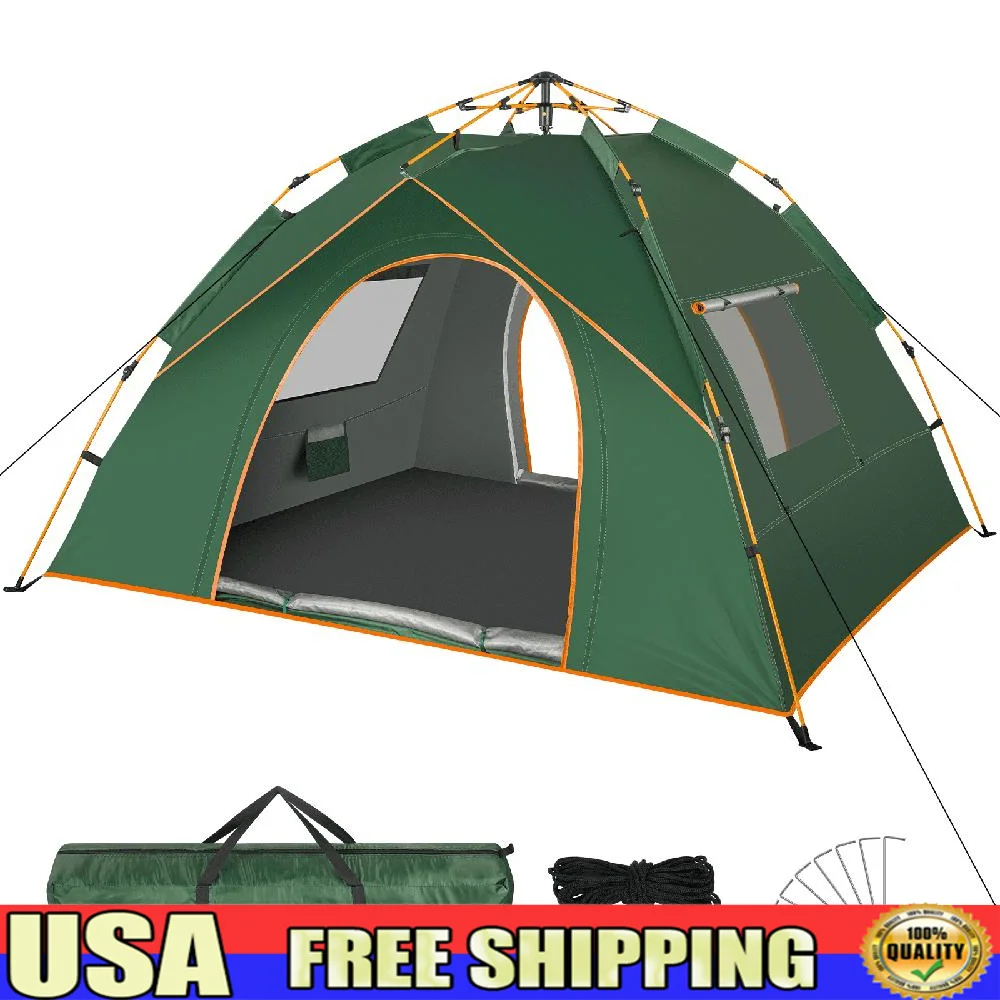
Key Features for Couples Hiking Tents
When hiking as a couple, certain tent features become particularly important for maintaining harmony and comfort in your shared shelter:
Dual-Door Design: Perhaps the single most important feature for couples, two doors eliminate the need to climb over your partner for nighttime bathroom trips. This seemingly small convenience becomes crucial after long days on the trail when sleep is precious. Look for doors positioned at the head and foot or on opposite sides for maximum benefit.
Vestibule Configuration: Ideal couples’ tents feature two vestibules (one outside each door) providing dedicated storage space for each person’s boots, backpack, and other gear. This keeps the tent interior clean and maximizes usable sleeping space. Together, vestibules should offer at least 15-20 square feet of covered storage.
Interior Width: For comfortable sleeping, the tent should accommodate two standard sleeping pads (typically 20-25 inches wide each) with a small gap between. This means a minimum width of 48-52 inches, though 54+ inches provides noticeably more comfort for couples. Length should be at least 84 inches to accommodate taller hikers.
Headroom Profile: Beyond just peak height, consider the wall slope. More vertical walls create usable space for two people to sit up simultaneously without hunching. This feature becomes especially valuable during extended periods inside the tent due to poor weather.
Privacy Considerations: When camping with others nearby, features like opaque walls (versus transparent mesh when the rainfly is removed) and strategic door positioning offer valuable privacy for changing clothes and intimate moments. These features matter more for couples than solo hikers.
Understanding these specific requirements helps you evaluate camping shelter options for two more effectively, ensuring your tent enhances rather than detracts from your shared outdoor experience.
Weight and Portability: Critical Factors for Hiking
For hiking couples, tent weight and portability directly impact your energy levels and enjoyment on the trail. Understanding these factors helps you make appropriate compromises between setup convenience and carrying comfort:
Pop-Up Packing Challenges: True pop-up tents typically fold into flat, circular shapes rather than the cylindrical packages of traditional tents. These awkward dimensions (often 20-24 inches in diameter) must usually be strapped to the outside of a pack rather than placed inside, affecting balance and increasing the risk of damage or snagging on trail obstacles.
Weight Distribution Strategies: Couples have the advantage of sharing tent weight between two backpacks. Consider separating components (one carries poles/stakes, the other the canopy/fly) or alternating carrying days to distribute the burden fairly. Even a 6-pound tent becomes reasonable when split into 3-pound loads.
Realistic Weight Guidelines:
* For weekend trips (1-2 nights): Up to 6 pounds total weight is acceptable
* For extended trips (3-7 days): Aim for 4-5 pounds maximum
* For long-distance treks (7+ days): Prioritize tents under 4 pounds
Compression Techniques: Many quick-setup tents can pack smaller than their included stuff sacks suggest. Consider using compression straps or aftermarket compression sacks to reduce packed volume by 15-25%. Remove poles and pack them separately alongside the pack’s interior for better weight distribution.
When evaluating options in the easy setup camping tent category, remember that an extra pound might seem insignificant in the store but becomes very noticeable after miles on the trail. The ideal tent balances setup convenience with reasonable weight and pack size.
Are Pop-Up Tents Actually Waterproof Enough?
Waterproof performance is a critical consideration for any hiking tent, but pop-up and quick-pitch designs face particular challenges in this area that couples should understand:
Understanding Waterproof Ratings: Tent waterproofing is measured in millimeters of water column – essentially how much water pressure the fabric can withstand before leaking. Adequate protection requires minimum ratings of:
* Tent floor: 1200-1500mm (higher is better)
* Rainfly: 1000-1500mm for three-season use
* Seams: Must be taped or sealed regardless of fabric rating
Common Limitations in Pop-Up Designs: Traditional pop-ups often use simplified construction with fewer sealed seams and integrated rainflies. This creates more potential failure points during sustained rain. Additionally, their typically flatter roof designs allow water pooling rather than efficient runoff, increasing leak risks during heavy precipitation.
Seam Sealing Importance: While premium tents come with factory-sealed seams, budget-friendly options (including many pop-ups) may require DIY seam sealing. This simple process using silicone sealer significantly improves waterproofness and should be completed before your first trip in rainy conditions.
Condensation Management: With two people breathing inside a small space, condensation becomes a significant concern. Most rapid-setup tents sacrifice some ventilation features for simplicity, potentially creating internal dampness that feels like leaking. Look for models with adjustable vents at high and low positions to create necessary airflow.
Supplemental Protection Options: For less water-resistant designs, consider carrying a lightweight tarp to pitch above your tent in extremely wet conditions or use a tent-specific groundsheet to prevent water intrusion from below. These simple additions can significantly enhance protection during unexpected downpours.
For detailed information about performance in wet conditions, exploring how pop-up tents stay dry in rain can provide valuable insights before making your purchase.
Can You Really Backpack with a Pop-Up Tent?
This question deserves a nuanced answer based on tent design, trip type, and personal preferences:
Yes, You Can Backpack With:
* Quick-pitch tents specifically designed for hiking (all our top-rated options)
* True pop-ups on very short backpacking trips (under 3 miles to campsite)
* Pop-ups when weight is distributed between partners
* Ultralight quick-pitch designs even on longer treks
No, Backpacking Is Impractical With:
* Traditional pop-ups on distances over 3-5 miles
* Any pop-up design on technical trails requiring balanced loads
* Bulky pop-ups during windy conditions (awkward carrying)
* Budget pop-ups with questionable durability
Distance Limitations: The practical hiking distance with a true pop-up tent depends heavily on its packed shape and weight. Most become uncomfortable to carry beyond 2-3 miles, making them suitable primarily for very short backpacking approaches or campsites close to trailheads.
Sharing Strategies: Couples can mitigate weight issues by dividing tent components between packs. One person might carry the tent body while the other manages stakes, rainfly, and footprint. This distribution makes marginally heavy tents more practical over distances.
Alternative Quick-Pitch Options: For serious backpacking, look to quick-pitch designs with hub-style poles rather than true pop-ups. These options set up in 1-3 minutes while packing much more efficiently for hiking. Modern hub designs have nearly eliminated the traditional time-consuming aspect of tent setup while maintaining trail-friendly packed shapes.
For most hiking couples, easy setup tents for weekend camping that feature quick-pitch technology rather than true pop-up design offer the best balance between setup convenience and backpacking practicality.
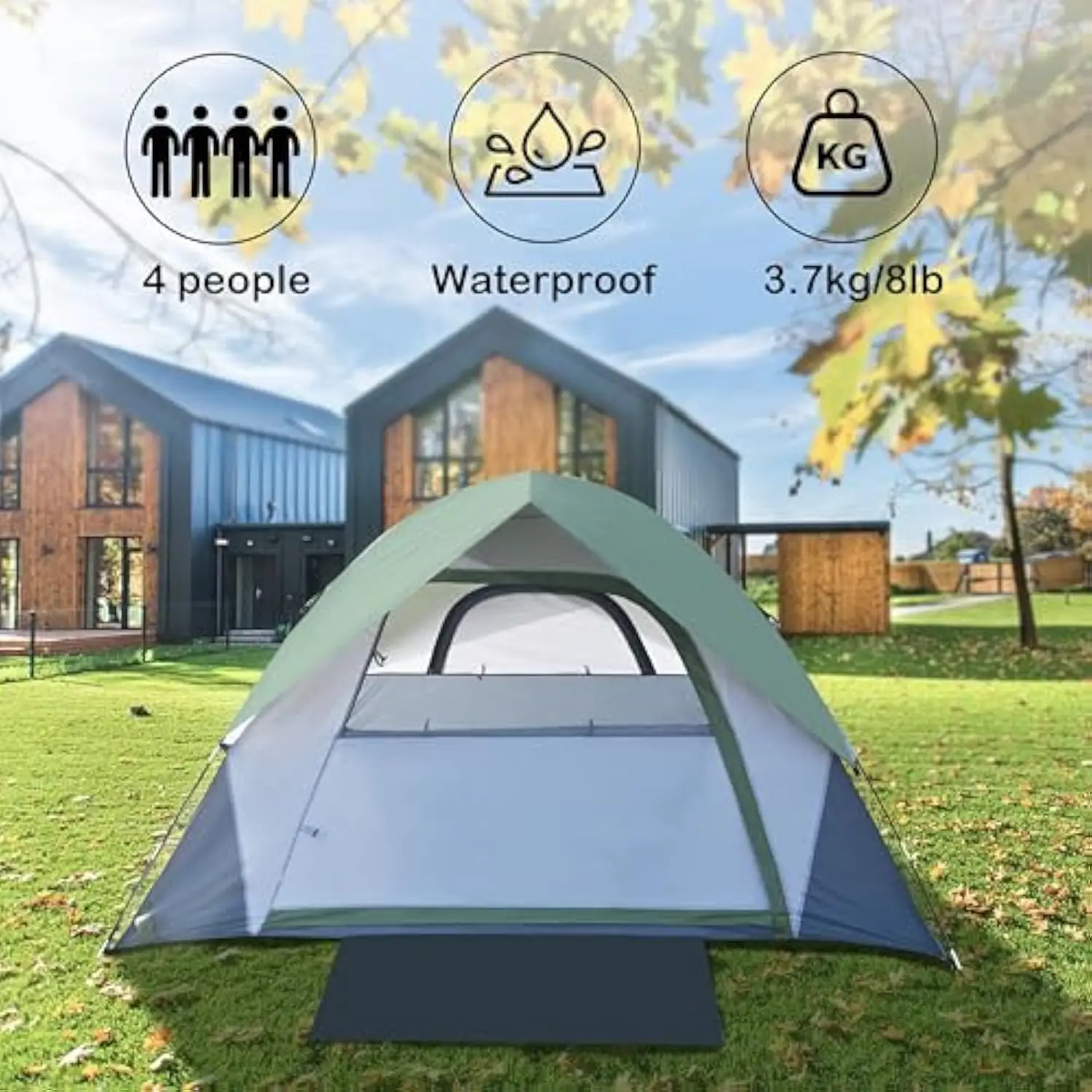
Care and Maintenance Tips for Quick-Setup Tents
Proper maintenance is essential for ensuring the longevity of your quick-setup tent, particularly given the complex mechanisms that enable their rapid deployment:
Always Dry Completely: Never pack your tent away damp – even slight moisture can create mildew that damages waterproof coatings and creates unpleasant odors. Fully open and air-dry both the rainfly and tent body before storage, even if this means setting it up again at home after a rainy trip.
Clean Hub Mechanisms Regularly: The hub systems on quick-pitch tents can collect dirt and debris that impair function. After dusty or muddy trips, clean these components with a soft brush and warm water, then dry thoroughly before storing.
Proper Folding Technique: True pop-up tents require specific folding sequences to avoid damaging the spring-loaded frame. Follow manufacturer instructions precisely and practice at home before your trip. Forcing incorrect folds can permanently damage the structure.
Safe Cleaning Products: Use only gentle, non-detergent soaps specifically formulated for outdoor gear. Regular household cleaners can damage waterproof coatings. For spot cleaning, lukewarm water and mild soap applied with a sponge works best.
Strategic Storage: Store your tent loosely packed in a dry, cool location. Avoid compressing it in its stuff sack during long-term storage, as this can damage waterproof coatings and crease fabrics. Consider using a larger cotton or mesh storage bag between trips.
Regular Reproofing: Apply tent-specific waterproofing treatments every 1-2 seasons depending on use. Focus on high-wear areas and seams where waterproofing typically fails first.
Understanding how instant tents work for couples helps you better maintain the specific mechanisms that enable their quick setup, ensuring your investment provides shelter for years of adventures together.
Conclusion: Finding Your Perfect Quick-Setup Tent
After exploring the full spectrum of pop-up and quick-pitch options for hiking couples, several key considerations emerge to guide your final decision:
For most hiking couples, the sweet spot lies with quick-pitch designs rather than true pop-ups. The Mountain Summit Instant Dome offers the best overall balance of rapid setup, reasonable weight, and couples-friendly features that enhance rather than detract from your outdoor experience. Its dual-door design and effective weather protection make it suitable for a wide range of adventures.
Those focusing on longer distances should prioritize the Featherlight Quick-Pitch, accepting its slightly reduced space and weather resistance in exchange for significant weight savings. The difference becomes increasingly noticeable with each passing mile on extended trips.
Couples who frequently encounter challenging weather conditions will appreciate the Alpine Fortress Fast-Pitch’s superior stability and protection despite its weight penalty. When facing uncertain forecasts, this added confidence proves well worth carrying the extra pounds.
Budget-conscious couples still desiring quick setup should consider the TrailEasy QuickPitch. Its performance-to-price ratio offers excellent value for occasional weekend adventures without major compromises in essential features.
When making your final selection, prioritize your specific hiking style rather than marketing claims. Consider your typical trip duration, usual weather conditions, and how you’ll distribute the tent weight between partners. Remember that the best tent facilitates your adventures rather than becoming an obstacle to enjoying them.
For more detailed information on selecting the ideal shelter for your adventures together, explore our guide to best compact shelters for two.
Frequently Asked Questions
How do you fold a pop-up tent back into its carry bag?
True pop-up tents typically require folding into flat circles by holding opposite edges, twisting to form a figure-eight, and then folding the circles together. Each model has specific techniques, so practice at home before your trip and consider watching the manufacturer’s video tutorials for your exact model. Most people need 5-10 practice attempts before mastering the technique.
What’s the actual difference in setup time between pop-up and quick-pitch tents?
True pop-ups deploy in 5-10 seconds versus 1-3 minutes for quick-pitch designs. However, takedown shows a smaller gap, with pop-ups requiring 2-4 minutes (once mastered) compared to 3-5 minutes for quick-pitch models. The real advantage of quick-pitch is their superior packability despite the slightly longer setup.
How much interior space do two adults really need?
For comfortable sleeping, two adults need a tent with minimum dimensions of 50-54 inches wide by 80-85 inches long. This accommodates standard sleeping pads (typically 20-25 inches wide each) with a small buffer between. For extended bad-weather trips where you’ll spend waking hours inside, prioritize models with at least 40 inches of peak height and more vertical walls.
Do pop-up tents have enough ventilation for two people?
Many basic pop-up designs have insufficient ventilation for two occupants, leading to significant condensation. Look for models with multiple mesh panels, adjustable vents at both high and low positions, and the ability to create cross-ventilation with partially open rainfly configurations. Two breathing adults can produce surprising amounts of moisture overnight, making proper airflow essential.
Are quick-pitch tents more likely to fail in strong winds?
Quality quick-pitch tents with hub-style pole systems are actually more stable than many traditional tents due to their unified structure. However, true pop-up designs with circular or oval shapes and minimal staking points often perform poorly in winds above 15 mph. For reliability in varied conditions, choose quick-pitch designs with full staking options over true pop-ups.

